Big Data Spatio-Temporal Correlation Analysis and LRIM Model Based Targeted Poverty Alleviation through Education
Abstract
:1. Introduction
2. Data
2.1. Population Number with Different Education Levels
2.2. GDP/C Indicator
2.3. Nighttime Remote Sensing Data
3. Methods
3.1. Proposed Research Framework
3.2. Correlation Analysis Method
3.2.1. Calculation of AEY
3.2.2. Calculation of Correlation Coefficient
3.2.3. Random Forest Classification Algorithm
3.2.4. Spatial Autocorrelation Analysis
3.3. Analysis Method of Influencing Factors
3.3.1. Influencing Indicator Selection
3.3.2. Principal Component Analysis
3.4. Proposed LRIM Model
- (1)
- Model the linear autocorrelation main body through ARIMA model, determine the parameters of ARIMA (p, d, q) to establish a prediction model, and obtain the prediction result . And subtract the prediction result and the original time series to get the residual.
- (2)
- The residual sequence contains the nonlinear part of the original sequence, and uses BP neural network model to describe this nonlinear relationship. Assuming that there are a pieces of input data in BP, the residual sequence is expressed as:
- (3)
- Integrate the predicted values of the two parts, namely:
4. Results and Discussion
4.1. Correlation between Education Levels and Poverty
4.1.1. Similarity of Spatial Distribution Pattern
4.1.2. Correlation between AEY and GDP/C
4.1.3. Correlation between AEY and Poor Counties Distribution
4.2. Analysis of Influencing Factors of Education levels
4.3. Prediction of AEY in Provinces
4.3.1. Prediction Results of ARIMA Model
4.3.2. Prediction Results of BP Model
4.3.3. Prediction Results of LRIM Model
5. Conclusions
- (1)
- There is a significant positive correlation between AEY and GDP/C. The higher AEY is, the higher the local GDP, showing that AEY can be used as an indicator of PAE to a certain extent. By increasing AEY, it can help the locals to improve their economic level and eliminate poverty.
- (2)
- There is a negative correlation between AEY and the distribution of poor counties. It indicates that the low level of local education is to some extent a factor causing poverty in the region. Moreover, by increasing AEY in the region, the local poverty situation can be improved, therefore, PAE is an important channel for TPA in China.
- (3)
- The industry population structure, the natural population growth rate, and the compulsory education funding have become the main factors affecting the level of regional education development. By continually improving the above three influencing factors can enhance the overall AEY in provinces, ultimately helping the region eliminate poverty.
- (4)
- The LRIM model constructed in this research is used to predict and analyze AEY in provinces of China based on historical data. In 2020, AEY in most regions of China has basically reached the national nine-year compulsory education, however, there are still some regions, such as Tibet, Guizhou, Yunnan, and Fujian, where AEY are very low. The above regions are identified as key regions for TPAE in the future. Only by realizing the improvement of education levels in these regions can the goal of TPAE in China be achieved.
- (5)
- Finally, on the basis of the above research, we have designed and developed a WeChat mini-program of “Through Train for TPAE”, which serves as a one-to-one assistance platform between TPAE volunteers and poor students to promote the implementation of TPAE.
Author Contributions
Funding
Data Availability Statement
Acknowledgments
Conflicts of Interest
References
- Liu, Y.S.; Zhou, Y.; Liu, J.L. Regional Differentiation Characteristics of Rural Poverty and Targeted Poverty Alleviation Strategy in China. Bull. Chin. Acad. Sci. 2016, 311, 269–278. [Google Scholar]
- Li, Y.H.; Wang, Y.F.; Liu, Y.S. Impact and Mechanism of Social Capital in Poverty Alleviation of China. Bull. Chin. Acad. Sci. 2016, 3, 302–308. [Google Scholar]
- Zou, W.K. SWOT Analysis of Precision Poverty Alleviation—Taking Jinxian County as an Example. Old Dist. Constr. 2016, 10, 14–16. [Google Scholar]
- Li, K.; Ye, X.J. Rural Precise Poverty Alleviation: Analysis on Theoretical Bases and Practical Situations—Also on Compound Poverty Governance System Building. Res. Fujian-Taiwan Relatsh. 2015, 002, 26–33. [Google Scholar]
- Dong, J.F. Precise Credit Poverty Alleviation in Minority Areas. Guizhou Ethn. Stud. 2014, 35, 154–157. [Google Scholar]
- Liu, Y.; Guo, Y.; Zhou, Y. Poverty Alleviation in Rural China: Policy Changes, Future Challenges and Policy Implications. China Agric. Econ. Rev. 2018, 10, 241–259. [Google Scholar] [CrossRef] [Green Version]
- Wu, L.F. Analysis on the Dilemma of Rural Public Management under Targeted Poverty Alleviation. Shanxi Agric. Econ. 2021, 4, 142–143. [Google Scholar]
- Ruoqi, C.; Zheng, Y.H.; Wei, S.Y.; Peisong, L. Research on the Mechanism of Precision Poverty Alleviation in Industry Poverty Alleviation—Taking Aba Prefecture as an Example. In Proceedings of the 2018 International Conference on Education, Psychology, and Management Science (ICEPMS 2018), Shanghai, China, 13–14 October 2018. [Google Scholar]
- Zhao, J.N.; Bao, J.; Meng, H.T.; Liu, C. Data—Taking Fuxin Mongolian Autonomous County of Liaoning Province as an Example. Manag. Technol. SME 2021, 4, 174–175. [Google Scholar]
- Zhang, J.; Zhang, Y.; Cheng, M.; Yu, N.; Wei, X.; Zhang, Z. Impact of Information Access on Poverty Alleviation Effectiveness: Evidence from China. IEEE Access 2019, 7, 149013–149025. [Google Scholar] [CrossRef]
- Zhong, H. Education for Poverty Alleviation is the Most Effective and Direct Accurate Poverty Alleviation: An Interview with Zhong Binglin, President of the China Education Association. Chin. Natl. Educ. 2016, 5, 22–24. [Google Scholar]
- Song, S.Y.; Liu, J.X. Research on Practical Problems and Countermeasures of Targeted Poverty Alleviation through Education. J. Heilongjiang Vocat. Inst. Ecol. Eng. 2021, 34, 101–103. [Google Scholar]
- Xue, E.Y.; Zhou, X.P. Education and anti-poverty: Policy theory and strategy of poverty alleviation through education in China. Educ. Philos. Theory 2018, 50, 1101–1112. [Google Scholar]
- Simone, D. Why education is not helping the poor. Findings from Uganda. World Dev. 2018, 110, 124–139. [Google Scholar]
- Liu, B.L. Research on the Performance Evaluation of Educational Precision Poverty Alleviation in Deep Poverty Areas. Econ. Res. Guide 2020, 2. [Google Scholar]
- Sun, X.; Guo, Y. The Ways of Educational Targeted Poverty Alleviation for the Poor in Rural Areas in Chongqing. Educ. Sci. Theory Pract. 2018, 18, 6. [Google Scholar]
- Yuan, X.Y. Research on the Theoretical Basis, Profound Connotation and Measures of “Poverty Alleviation Though Education”. Comp. Study Cult. Innov. 2021, 5, 5–8. [Google Scholar]
- Peters, M.A.; Besley, T. Children in Crisis: Child Poverty and Abuse in New Zealand. Educ. Philos. Theory 2014, 46, 945–961. [Google Scholar] [CrossRef] [Green Version]
- Meng, Z.H.; Yu, H.; Li, Y.L. Evaluation of Poverty Alleviation in Education Based on GIS: A Case Study of Gansu. J. Henan Inst. Educ. 2019, 28, 46–54. [Google Scholar]
- Sun, B.C.; Liu, Y.P. Estimating Educational Equality between Regions and Genders in China—Based on Gini Coefficients of Education from 2002 to 2012. Tsinghua J. Educ. 2014, 35, 87–95. [Google Scholar]
- Liu, L.L. The Research on the New Pattern and New Approach to Accurate Poverty Alleviation in Henan Based on Big Data Analysis. In Proceedings of the 2017 9th International Conference on Measuring Technology and Mechatronics Automation (ICMTMA), Changsha, China, 14–15 January 2017; pp. 422–426. [Google Scholar]
- Ma, L.L.; Xu, D.G. Analysis of the Effect of Factors on the Average Years of Education in China. J. Minzu Univ. China 2009, 18, 139–142. [Google Scholar]
- Janjua, P.Z.; Kamal, U.A. The Role of Education and Health in Poverty Alleviation a Cross Country Analysis. J. Econ. Manag. Trade 2014, 896–924. [Google Scholar] [CrossRef] [PubMed]
- Chen, Q. Comparison and Reference of the Policies of Education Precision and Poverty Alleviation in Developed Countries—Take the United States, Britain, France, and Japan as Examples. Contemp. Educ. Sci. 2019, 3, 40–46. [Google Scholar]
- Liu, W.; Li, J.; Zhao, R. The Effects of Rural Education on Poverty in China: A Spatial Econometric Perspective. J. Asia Pac. Econ. 2021, 2, 1–23. [Google Scholar] [CrossRef]
- Xu, C.S.; Li, T.; Li, N. Study of Poverty Reduction Effect of Financial Education Expenditure on Poverty Alleviation—An Empirical Analysis Based on Spatial Dynamic Panel Model. J. Tianjin Univ. Commer. 2021, 41, 63–72. [Google Scholar]
- Paraschiv, C.I. The Role of Education in Poverty Alleviation. Theor. Appl. Econ. 2017, 24. [Google Scholar]
- Spearman, C. General Intelligence, Objectively Determined and Measured. Am. J. Psychol. 1904, 15, 201–292. [Google Scholar] [CrossRef]
- Zhang, W.Y.; Wei, Z.W.; Wang, B.H.; Han, X.P. Measuring Mixing Patterns in Complex Networks by Spearman Rank Correlation Coefficient. Phys. A Stat. Mech. Appl. 2016, 451, 440–450. [Google Scholar] [CrossRef]
- Zhu, H.Q.; Wang, Y.Y.; Li, X.Q. An Analysis of the Disequilibrium of Educational Development—Based on the Empirical Study of Guizhou Province. Stat. Decis. 2019, 35, 93–96. [Google Scholar]
- Wang, Y.; Li, H. An Empirical Study on the Impact of Educational Gap on Income Gap. In Proceedings of the 2017 International Conference on Education Science and Economic Management (ICESEM 2017), Xiamen, China, 14–15 October 2017; pp. 14–15. [Google Scholar]
- Tan, N.H. Research on the Development Level of Higher Education in my country’s Central and Southwestern Provinces and Cities—Based on SPSS Analysis. Times Financ. 2020, 787, 86–88. [Google Scholar]
- Bishara, A.J.; Hittner, J.B. Reducing Bias and Error in the Correlation Coefficient due to Nonnormality. Educ. Psychol. Meas. 2015, 75, 785–804. [Google Scholar] [CrossRef]
- Xiao, C.; Ye, J.; Esteves, R.M.; Rong, C. Using Spearman’s Correlation Coefficients for Exploratory Data Analysis on Big Dataset. Concurr. Comput. Pract. Exp. 2016, 28, 3866–3878. [Google Scholar] [CrossRef]
- DaSilva, D.O.; Klausner, V.; Prestes, A.; Macedo, H.G.; Aakala, T.; da Silva, I.R. Principal Components Analysis: An Alternative Way for Removing Natural Growth Trends. Pure Appl. Geophys. 2021, 178, 3131–3149. [Google Scholar] [CrossRef]
- Breiman, L. Random Forests. Mach. Learn. 2001, 45, 5–32. [Google Scholar] [CrossRef] [Green Version]
- Ziegler, A.; König, I.R. Mining Data with Random Forests: Current Options for Real-World Applications. Wiley Interdiscip. Rev. Data Min. Knowl. Discov. 2014, 4, 55–63. [Google Scholar] [CrossRef]
- Li, X.H. Using “Random Forest” for Classification and Regression. Chin. J. Appl. Entomol. 2013, 50, 1190–1197. [Google Scholar]
- Song, H.Y.; Park, S. An Analysis of Correlation between Personality and Visiting Place using Spearman’s Rank Correlation Coefficient. KSII Trans. Internet Inf. Syst. 2020, 14, 1951–1966. [Google Scholar]
- Moran, P.A.P. Notes on Continuous Stochastic Phenomena. Biometrika 1950, 37, 17–23. [Google Scholar] [CrossRef] [PubMed]
- Chen, Y. New Approaches for Calculating Moran’s Index of Spatial Autocorrelation. PLoS ONE 2013, 8, e68336. [Google Scholar] [CrossRef] [PubMed] [Green Version]
- Zhang, T.; Lin, G. On Moran’s I Coefficient under Heterogeneity. Comput. Stat. Data Anal. 2016, 95, 83–94. [Google Scholar] [CrossRef]
- Thompson, E.S.; Saveyn, P.; Declercq, M.; Meert, J.; Guida, V.; Eads, C.D. Characterisation of Heterogeneity and Spatial Autocorrelation in Phase Separating Mixtures using Moran’s I. J. Colloid Interface Sci. 2018, 513, 180–187. [Google Scholar] [CrossRef]
- Hotelling, H. Analysis of a Complex of Statistical Variables into Principal Components. J. Educ. Psychol. 1933, 24, 417. [Google Scholar] [CrossRef]
- Vyas, S.; Kumaranayake, L. Constructing Socio-Economic Status Indices: How to Use Principal Components Analysis. Health Policy Plan. 2006, 21, 459–468. [Google Scholar] [CrossRef] [PubMed] [Green Version]
- Pérez-Arribas, L.V.; León-González, M.E.; Rosales-Conrado, N. Learning Principal Component Analysis by using Data from Air Quality Networks. J. Chem. Educ. 2017, 94, 458–464. [Google Scholar] [CrossRef]
- Mantas, C.J.; Castellano, J.G.; Moral-García, S.; Abellán, J. A Comparison of Random Forest Based Algorithms: Random Credal Random Forest versus Oblique Random Forest. Soft Comput. 2019, 23, 10739–10754. [Google Scholar] [CrossRef]
- Fattah, J.; Ezzine, L.; Aman, Z.; El Moussami, H.; Lachhab, A. Forecasting of Demand Using ARIMA Model. Int. J. Eng. Bus. Manag. 2018, 10, 1847979018808673. [Google Scholar] [CrossRef] [Green Version]

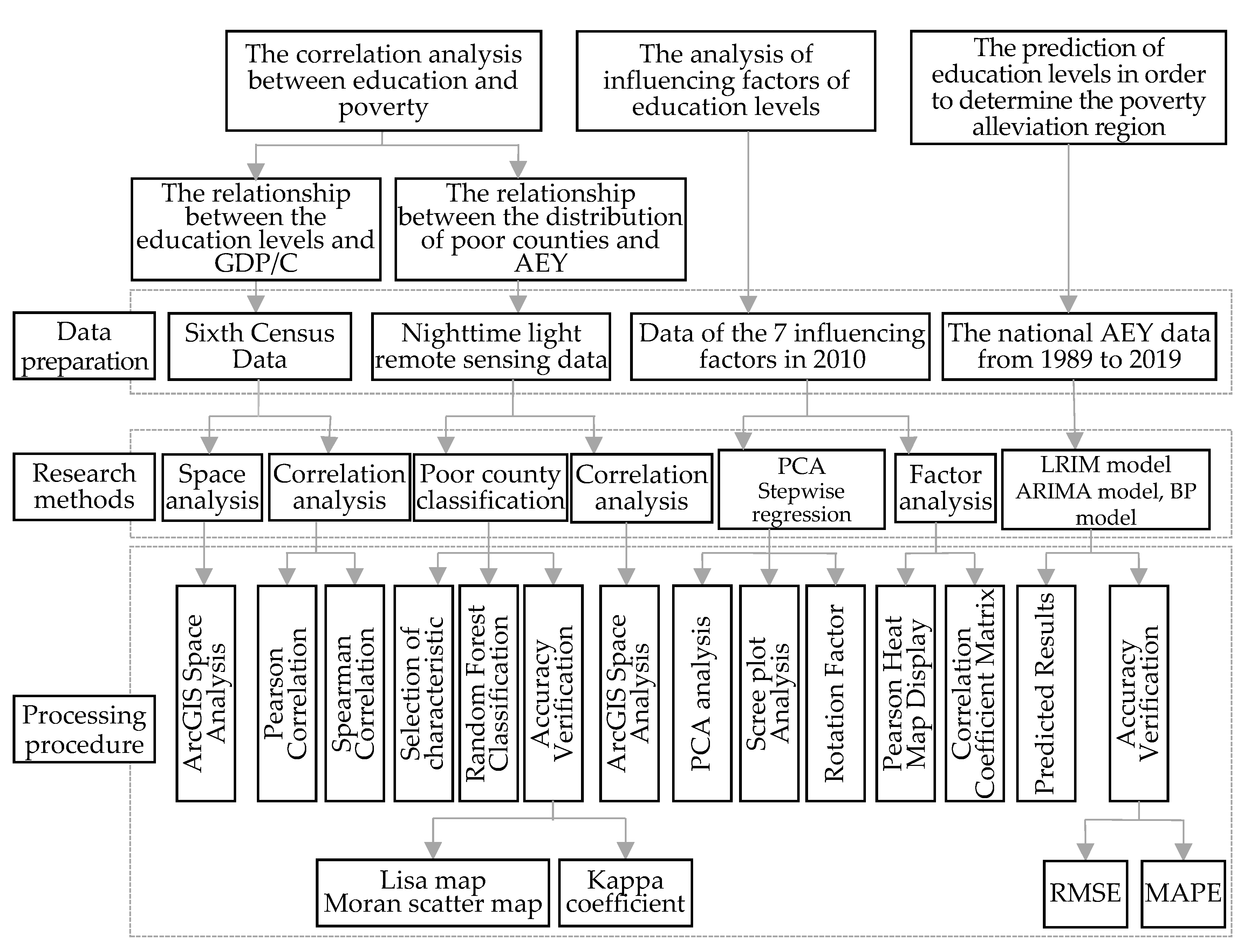

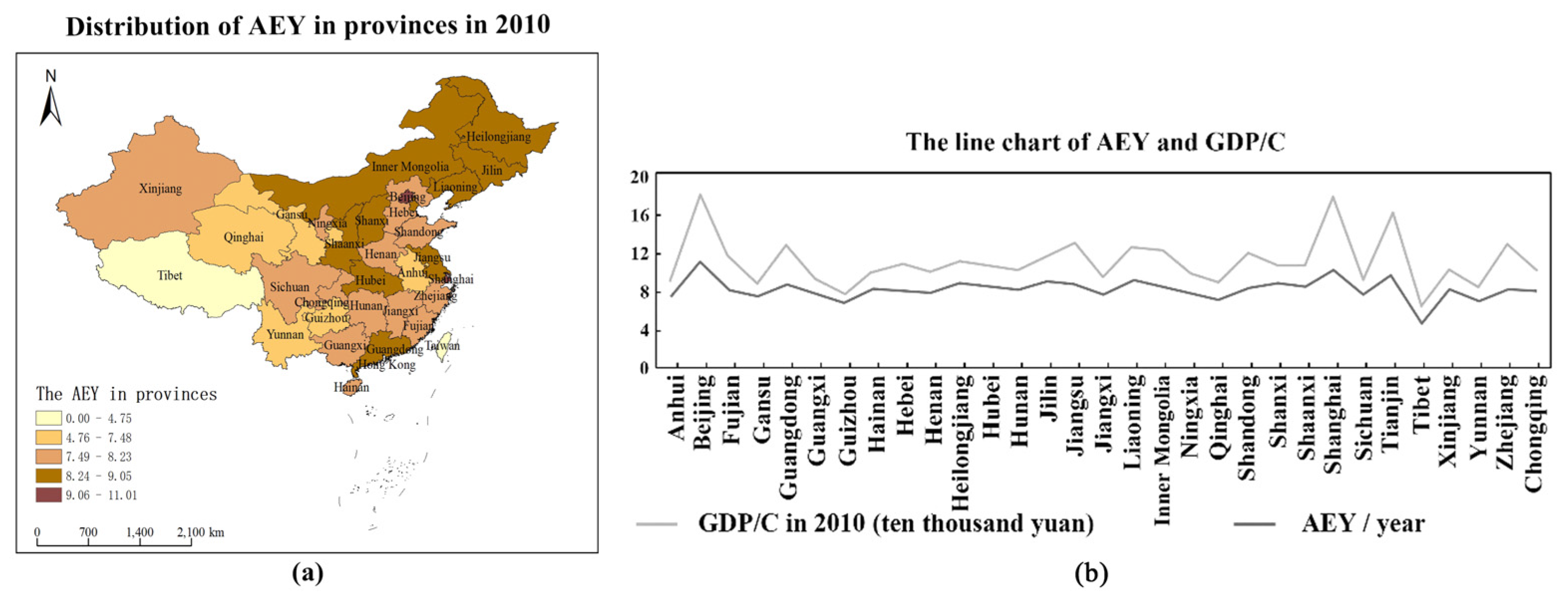


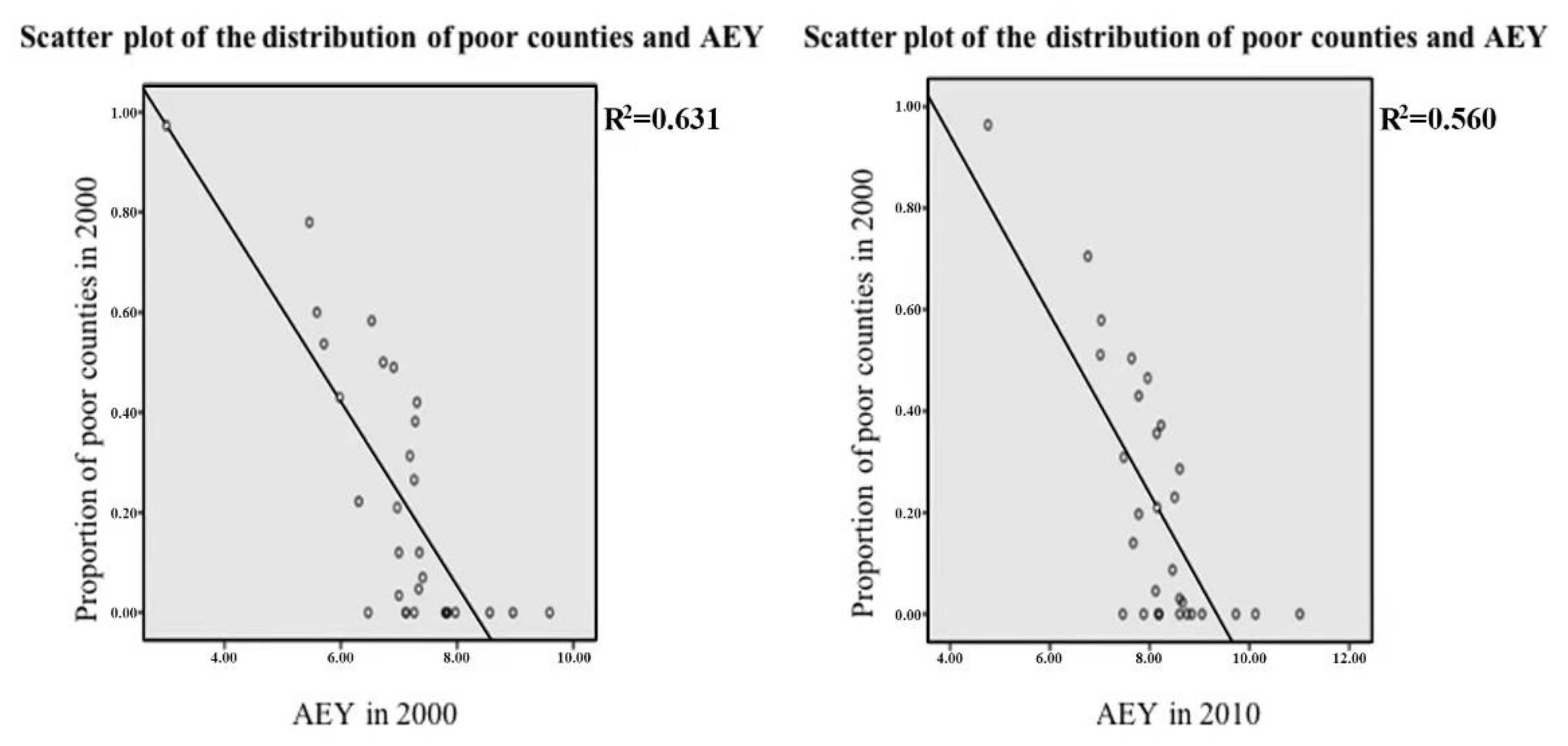


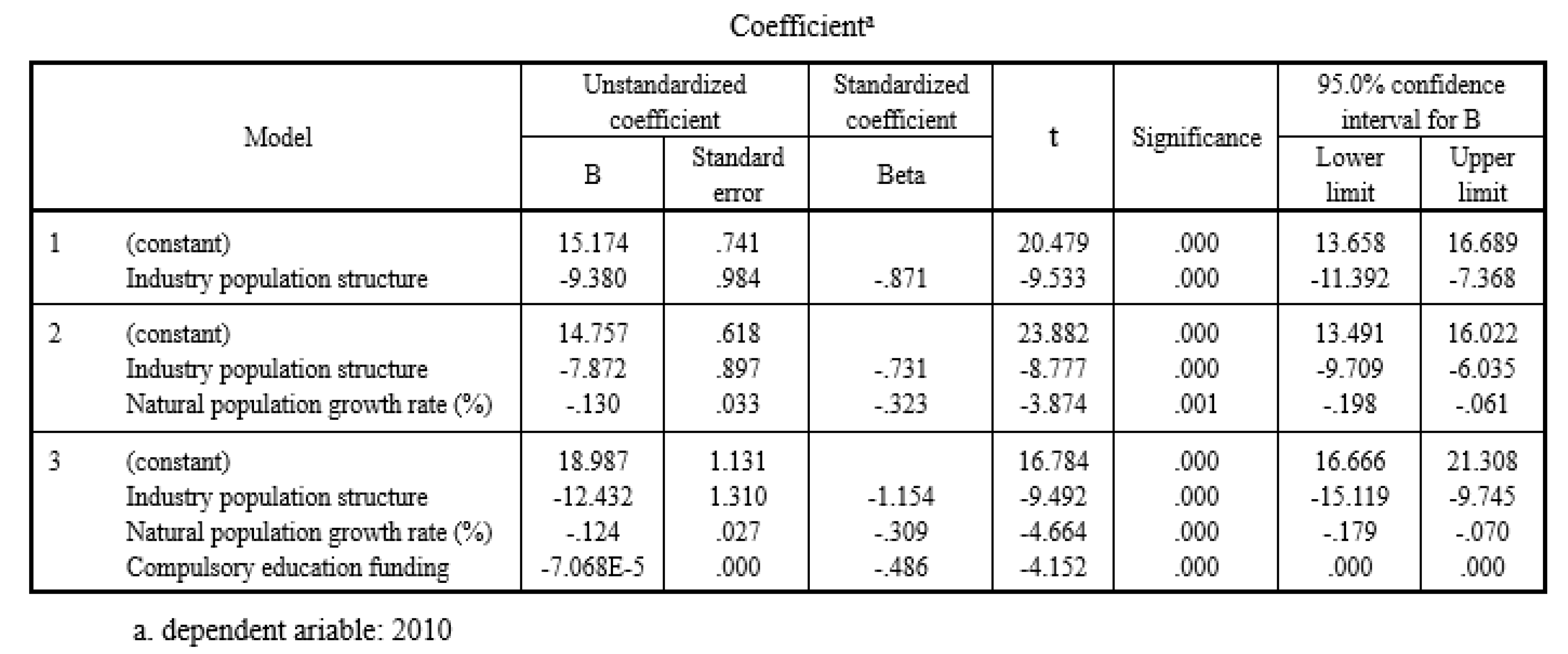

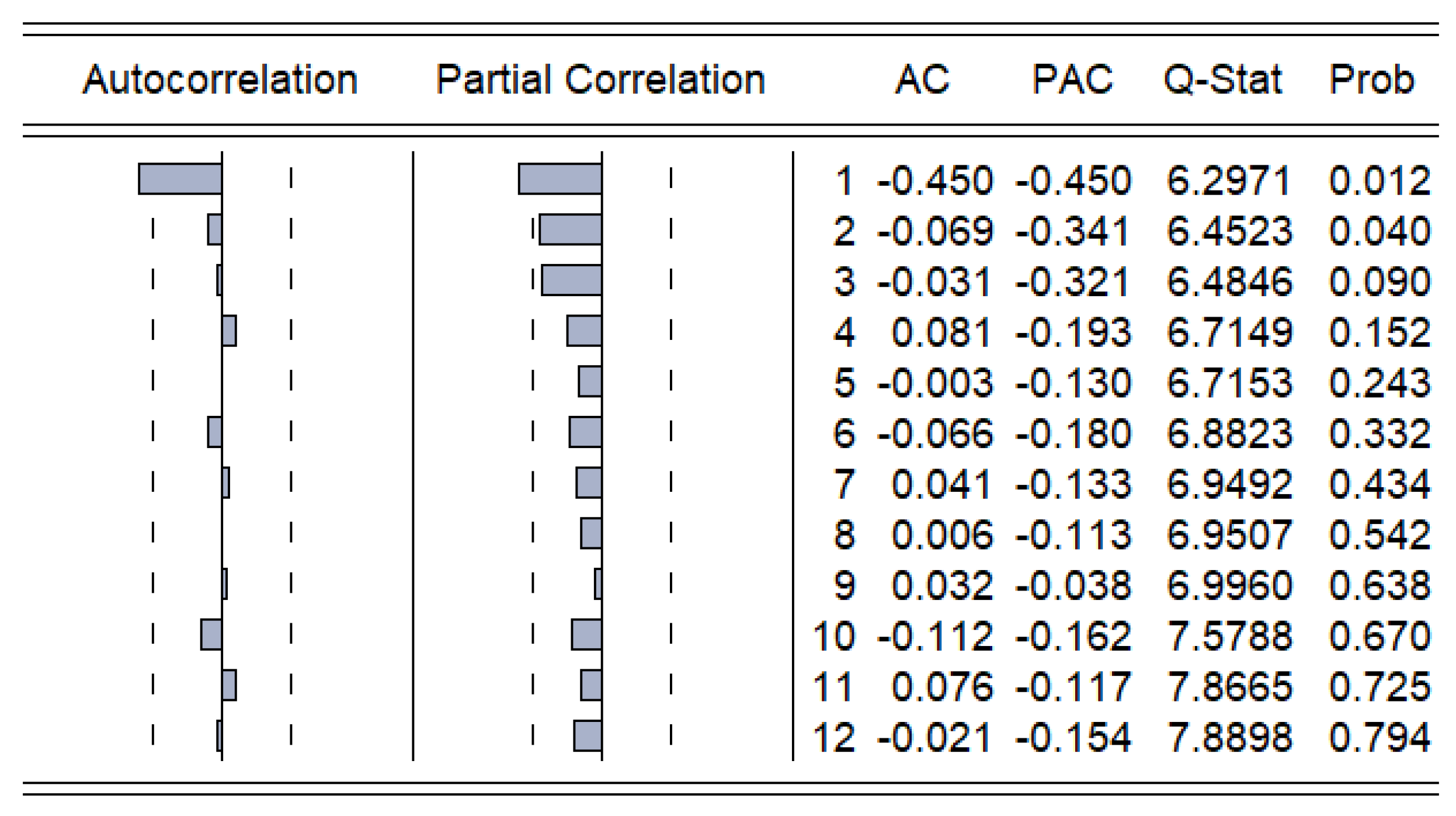


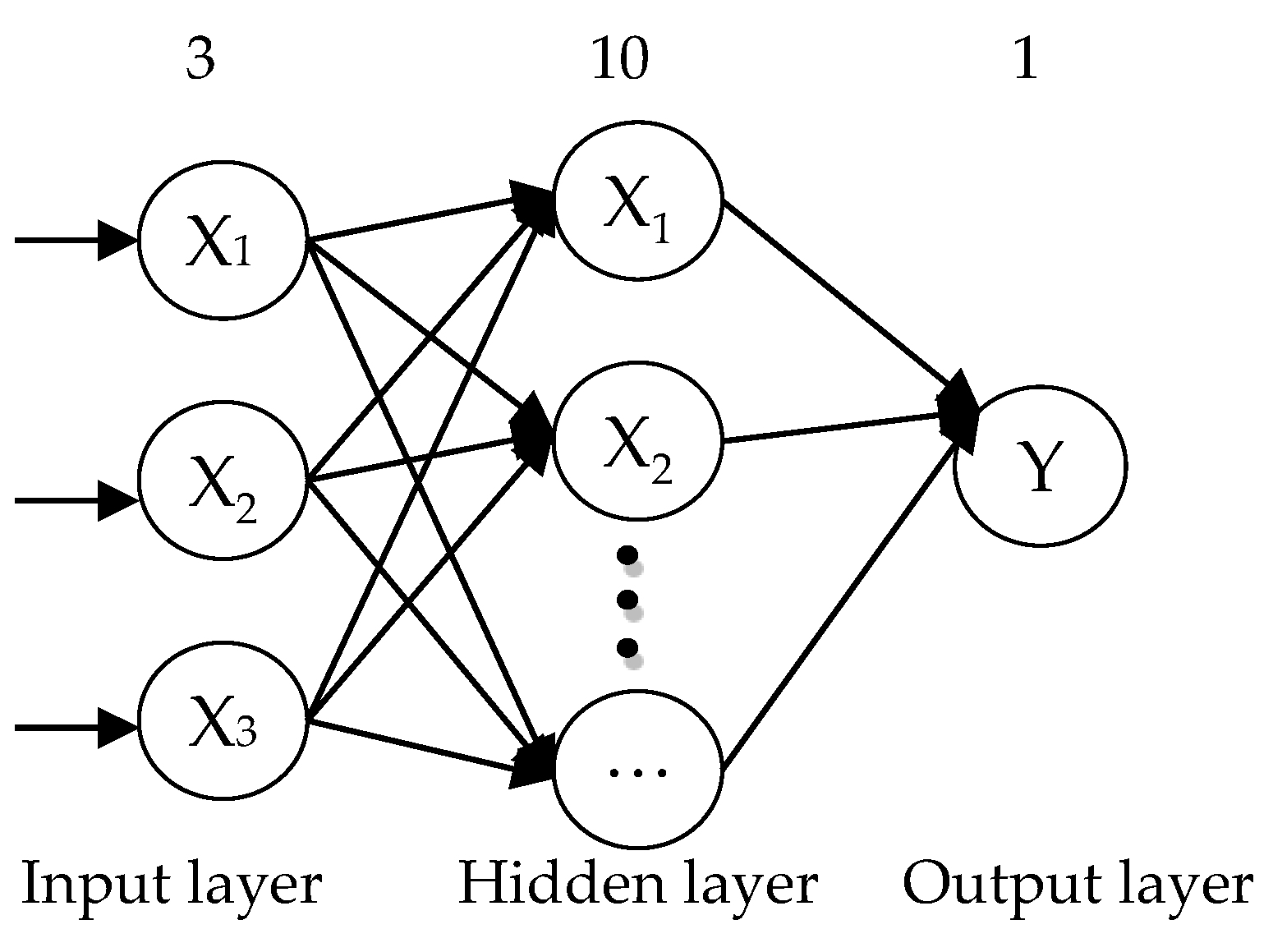

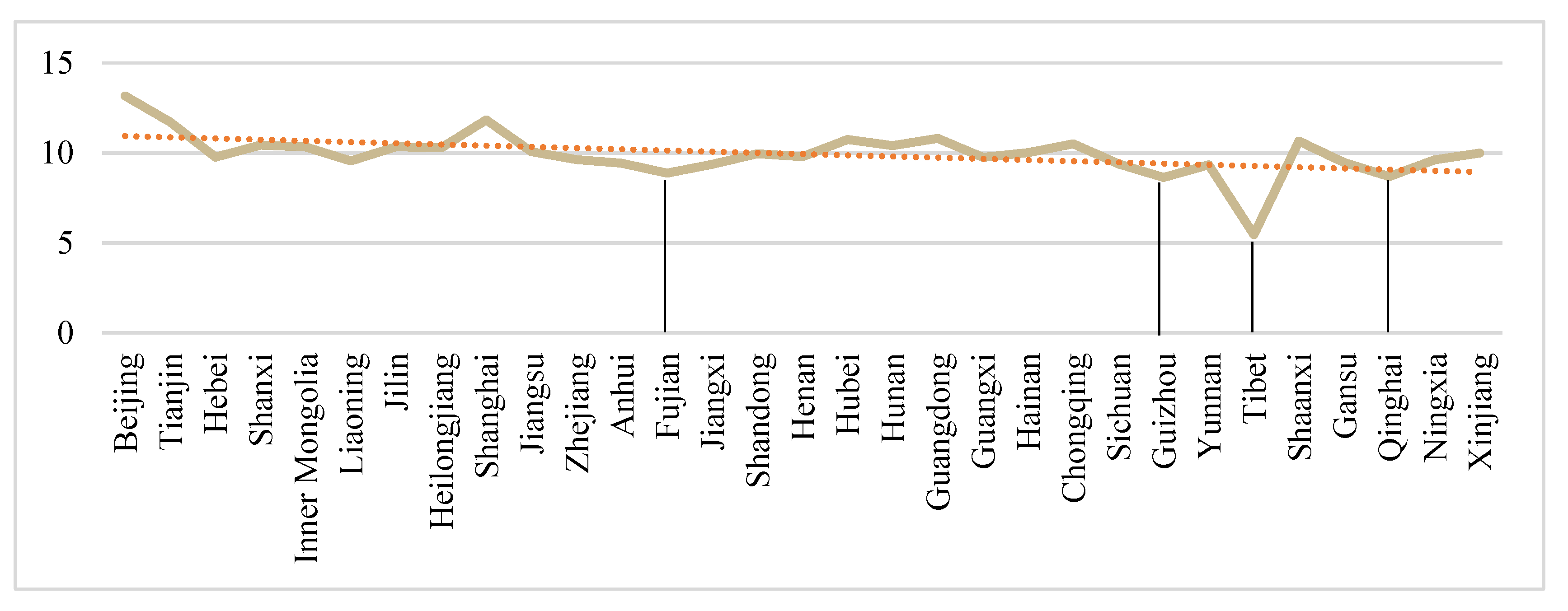
| Province | Illiteracy (10,000 People) | EEL (10,000 People) | JHEL (10,000 People) | HEL (10,000 People) | UEL (10,000 People) | GDP/C in 2010 (Yuan) |
|---|---|---|---|---|---|---|
| Anhui | 496.5 | 1662.9 | 2261.9 | 641 | 398.5 | 1.6656 |
| Beijing | 33.3 | 195.3 | 615.7 | 416.2 | 617.8 | 7.0234 |
| Fujian | 90 | 1099.4 | 1397.8 | 511.8 | 308.4 | 3.3106 |
| Gansu | 222.2 | 831.3 | 798.3 | 324.4 | 192.3 | 1.2882 |
| Guangdong | 204 | 2394.4 | 4476 | 1780.7 | 856.7 | 3.9978 |
| Guangxi | 124.9 | 1458.05 | 1784.15 | 507.9 | 275.14 | 1.6576 |
| Guizhou | 303.7 | 1368 | 1035 | 253 | 183.9 | 0.9214 |
| Hainan | 35.4 | 197.1 | 361.9 | 127.2 | 67.3 | 1.876 |
| Hebei | 187.7 | 1772 | 3190.4 | 913.1 | 524.2 | 2.4583 |
| Henan | 399.1 | 2266.7 | 3992.2 | 1242.2 | 601.5 | 2.1073 |
| Heilongjiang | 78.8 | 922.5 | 1727.1 | 574.3 | 347.4 | 2.1593 |
| Hubei | 261.9 | 1309.1 | 2267.6 | 950.2 | 545.6 | 2.205 |
| Hunan | 175.4 | 1759.3 | 2596.3 | 1012.8 | 498.8 | 1.9355 |
| Jilin | 52.7 | 660.7 | 1155.3 | 463.2 | 271.6 | 2.5906 |
| Jiangsu | 299.5 | 1901.7 | 3041.7 | 1269.8 | 850.7 | 4.3907 |
| Jiangxi | 139.4 | 1337.3 | 1684.2 | 549.3 | 305.2 | 1.5921 |
| Liaoning | 84.3 | 936.5 | 1982.9 | 646.9 | 523.4 | 3.4193 |
| Inner Mongolia | 100.5 | 628 | 968.9 | 373.7 | 252.2 | 3.7287 |
| Ningxia | 39.1 | 187.9 | 212.1 | 78.4 | 57.6 | 1.9642 |
| Qinghai | 57.6 | 198.4 | 142.8 | 58.7 | 48.5 | 1.8346 |
| Shandong | 475.73 | 2391.24 | 3846.82 | 1332.26 | 832.87 | 3.5893 |
| Shanxi | 76.2 | 780.5 | 1611.5 | 561.8 | 311.4 | 2.0779 |
| Shaanxi | 139.8 | 874.1 | 1498.1 | 588.8 | 394 | 2.0497 |
| Shanghai | 63.1 | 311.5 | 839.3 | 482.6 | 505.3 | 7.7205 |
| Sichuan | 437.7 | 2784.6 | 2805.7 | 904.5 | 536.8 | 1.7289 |
| Tianjin | 27.1 | 220.6 | 493.6 | 267.2 | 226.1 | 6.3395 |
| Tibet | 104.7 | 109.8 | 38.6 | 13.1 | 16.5 | 1.5294 |
| Xinjiang | 51.6 | 656 | 787.3 | 252.6 | 232 | 1.9119 |
| Yunnan | 277 | 1994.4 | 1263.1 | 385 | 265.6 | 1.3687 |
| Zhejiang | 306.1 | 1568.54 | 1996.41 | 738.12 | 507.78 | 4.4895 |
| Chongqing | 123.9 | 974.71 | 951.41 | 381.14 | 249.3 | 2.0219 |
| Categories | Indicators | Characteristics Description |
|---|---|---|
| Quantitative characteristics | A1 | The mean value of pixel lights in the county (MEAN) |
| A2 | The median of pixel lights in the county (MEDIAN) | |
| A3 | The mode number of pixel lights in the county (MAJORITY) | |
| Dispersion degree | A4 | The standard deviation of pixel lights in the county (STD) |
| A5 | The range of pixel lights in the county (RANGE) | |
| Distribution characteristics | A6 | The sum of pixel lights in the county (SUM) |
| A7 | The minimum pixel lights in the county (MIN) | |
| A8 | The maximum pixel lights in the county (MAX) | |
| A9 | The unique value of the pixel lights in the county (VERIETY) | |
| A10 | The least value of pixel lights in the county (MINORITY) | |
| Spatial characteristics | A11 | Local Moran’s I in the county (Moran’s I) |
| Year | Period | Year | Period | Year | Period | Year | Period |
|---|---|---|---|---|---|---|---|
| 1989 | 6.261 | 1997 | 7.009 | 2005 | 7.831 | 2013 | 9.048 |
| 1990 | 7.87 | 1998 | 7.088 | 2006 | 8.04 | 2014 | 9.037 |
| 1991 | 6.25 | 1999 | 7.179 | 2007 | 8.186 | 2015 | 9.077 |
| 1992 | 6.259 | 2000 | 7.114 | 2008 | 8.27 | 2016 | 9.078 |
| 1993 | 6.47 | 2001 | 7.621 | 2009 | 8.38 | 2017 | 9.21 |
| 1994 | 6.744 | 2002 | 7.734 | 2010 | 8.21 | 2018 | 9.38 |
| 1995 | 6.715 | 2003 | 7.911 | 2011 | 8.846 | 2019 | 9.5 |
| 1996 | 6.794 | 2004 | 8.01 | 2012 | 8.942 |
| Region | Natural Population Growth Rate (‰) | Urban-Rural Population Ratio (%) | Sex Ratio (Female = 100) | Industry Population Structure | GDP/C (Yuan) | Compulsory Education Funding (Yuan) | Students per Teacher Ratio |
|---|---|---|---|---|---|---|---|
| Beijing | 3.07 | 20.65 | 106.75 | 0.395 | 70,452 | 34,505.43 | 13.94 |
| Tianjin | 2.6 | 31.54 | 114.52 | 0.578 | 62,574 | 26,324.9 | 13.41 |
| Hebei | 6.81 | 79.98 | 102.84 | 0.798 | 24,283 | 9010.32 | 17.86 |
| Shanxi | 5.3 | 73.64 | 105.56 | 0.74 | 21,522 | 8788.71 | 19.06 |
| Inner Mongolia | 3.76 | 67.57 | 108.17 | 0.73 | 40,282 | 14,376.15 | 16.79 |
| Liaoning | 0.42 | 49.66 | 102.54 | 0.721 | 35,239 | 12,152.21 | 15.97 |
| Jilin | 2.03 | 62.86 | 102.67 | 0.738 | 26,595 | 13,047.16 | 15.67 |
| Heilongjiang | 2.32 | 63.14 | 102.85 | 0.75 | 22,447 | 11,078.51 | 16.09 |
| Shanghai | 1.98 | 23.36 | 106.19 | 0.502 | 78,989 | 35,953.83 | 15.09 |
| Jiangsu | 2.85 | 61.65 | 101.52 | 0.713 | 44,744 | 15,638.28 | 16.53 |
| Zhejiang | 4.73 | 62.54 | 105.69 | 0.736 | 44,641 | 15,114.9 | 18.2 |
| Anhui | 6.75 | 79.53 | 103.39 | 0.829 | 16,407 | 7155.67 | 23.87 |
| Fujian | 6.11 | 65.99 | 105.96 | 0.757 | 33,840 | 10,501.46 | 13.61 |
| Jiangxi | 7.66 | 83.16 | 106.67 | 0.8 | 17,335 | 5845.42 | 21.84 |
| Shandong | 5.39 | 70.39 | 102.33 | 0.771 | 35,894 | 10,073.39 | 16.56 |
| Henan | 4.95 | 80.5 | 102.05 | 0.802 | 20,280 | 5596.16 | 21.48 |
| Hubei | 4.34 | 68.68 | 105.55 | 0.757 | 22,677 | 7722.7 | 21.67 |
| Hunan | 6.4 | 80.61 | 105.8 | 0.758 | 20,226 | 7946.56 | 19.7 |
| Guangdong | 6.97 | 49.78 | 108.98 | 0.697 | 41,166 | 7407.99 | 20.96 |
| Guangxi | 8.65 | 81.85 | 108.26 | 0.813 | 16,045 | 7655.3 | 16.02 |
| Hainan | 8.98 | 73.2 | 112.58 | 0.753 | 19,254 | 11,380.08 | 23.38 |
| Chongqing | 2.77 | 69.9 | 102.61 | 0.773 | 23,026 | 7931.88 | 22.6 |
| Sichuan | 2.31 | 80.21 | 103.13 | 0.832 | 17,339 | 7449.52 | 23 |
| Guizhou | 7.41 | 84.06 | 106.31 | 0.865 | 10,971 | 5962.81 | 23.14 |
| Yunnan | 6.54 | 86.24 | 107.9 | 0.863 | 13,539 | 7635.31 | 21.92 |
| Tibet | 10.25 | 90.93 | 105.7 | 0.888 | 15,008 | 15,407.13 | 15.07 |
| Shaanxi | 3.72 | 76.33 | 106.92 | 0.752 | 21,485 | 9980.78 | 19.7 |
| Gansu | 6.03 | 79.44 | 104.42 | 0.81 | 12,802 | 7436.28 | 19.85 |
| Qinghai | 8.63 | 75.69 | 107.4 | 0.787 | 19,454 | 12,434.92 | 28.55 |
| Ningxia | 9.04 | 67.32 | 104.99 | 0.688 | 20,382 | 9828.54 | 19.54 |
| Xinjiang | 10.56 | 72.17 | 106.87 | 0.746 | 24,978 | 13,657.27 | 16.21 |
| Correlation | AEY in 2010 | GDP/C | ||
|---|---|---|---|---|
| Pearson correlation | AEY in 2010 | PCC | 1.000 | 0.729 |
| GDP/C | PCC | 0.729 | 1.000 | |
| Spearman correlation | AEY in 2010 | SCC | 1.000 | 0.754 |
| GDP/C | SCC | 0.754 | 1.000 | |
| Years | Overall Accuracy | Kappa Coefficient |
|---|---|---|
| 1995 | 97.5024% | 0.8950 |
| 2000 | 97.4305% | 0.8833 |
| 2005 | 96.6620% | 0.8523 |
| 2010 | 97.1094% | 0.8687 |
| KMO Measure of Sampling Adequacy | 0.805 | |
|---|---|---|
| Butterlit test of sphericity | Approximate chi-square number | 194.442 |
| Freedom degree | 21 | |
| Significance | 0.000 | |
| Characteristic | Regression Coefficient | p Value for Significance Test |
|---|---|---|
| Industry population structure (X4) | −1.154 | <0.001 |
| Natural population growth rate (X1) | −0.309 | <0.001 |
| Compulsory education funding (X6) | −0.486 | <0.001 |
| Evaluation Indicator | ARIMA | BP | LRIM |
|---|---|---|---|
| RMSE | 0.417 | 0.2795 | 0.1867 |
| MAPE | 3.698 | 2.1293 | 1.6240 |
| Province | Prediction Value | Province | Prediction Value | ||
|---|---|---|---|---|---|
| Beijing | 13.17149 | 0.1522 | Tianjin | 11.71074 | 0.2085 |
| Hebei | 9.766235 | 0.2124 | Shanxi | 10.439371 | 0.2207 |
| Inner Mongolia | 10.335862 | 0.2248 | Liaoning | 9.557991 | 0.169 |
| Jilin | 10.342367 | 0.1939 | Heilongjiang | 10.289159 | 0.1851 |
| Shanghai | 11.8419 | 0.2299 | Jiangsu | 10.07094 | 0.2299 |
| Zhejiang | 9.632423 | 0.2426 | Anhui | 9.428845 | 0.1757 |
| Fujian | 8.8743 | 0.2326 | Jiangxi | 9.37056 | 0.1807 |
| Shandong | 9.952434 | 0.1894 | Henan | 9.796795 | 0.227 |
| Hunan | 10.411652 | 0.2052 | Hunan | 10.74815 | 0.2672 |
| Guangdong | 10.81008 | 0.2018 | Guangxi | 9.752049 | 0.178 |
| Hainan | 10.01459 | 0.2358 | Chongqing | 10.506915 | 0.2032 |
| Sichuan | 9.390266 | 0.1994 | Guizhou | 8.633355 | 0.2097 |
| Yunnan | 9.340406 | 0.1967 | Tibet | 5.456407 | 0.1926 |
| Shaanxi | 10.665378 | 0.2209 | Gansu | 9.468711 | 0.1676 |
| Qinghai | 8.688841 | 0.2038 | Ningxia | 9.620349 | 0.1851 |
| Xinjiang | 9.9956 | 0.1647 |
Publisher’s Note: MDPI stays neutral with regard to jurisdictional claims in published maps and institutional affiliations. |
© 2021 by the authors. Licensee MDPI, Basel, Switzerland. This article is an open access article distributed under the terms and conditions of the Creative Commons Attribution (CC BY) license (https://creativecommons.org/licenses/by/4.0/).
Share and Cite
Han, Y.; Liu, L.; Sui, Q.; Zhou, J. Big Data Spatio-Temporal Correlation Analysis and LRIM Model Based Targeted Poverty Alleviation through Education. ISPRS Int. J. Geo-Inf. 2021, 10, 837. https://doi.org/10.3390/ijgi10120837
Han Y, Liu L, Sui Q, Zhou J. Big Data Spatio-Temporal Correlation Analysis and LRIM Model Based Targeted Poverty Alleviation through Education. ISPRS International Journal of Geo-Information. 2021; 10(12):837. https://doi.org/10.3390/ijgi10120837
Chicago/Turabian StyleHan, Yue, Lin Liu, Qiaoli Sui, and Jiaxing Zhou. 2021. "Big Data Spatio-Temporal Correlation Analysis and LRIM Model Based Targeted Poverty Alleviation through Education" ISPRS International Journal of Geo-Information 10, no. 12: 837. https://doi.org/10.3390/ijgi10120837
APA StyleHan, Y., Liu, L., Sui, Q., & Zhou, J. (2021). Big Data Spatio-Temporal Correlation Analysis and LRIM Model Based Targeted Poverty Alleviation through Education. ISPRS International Journal of Geo-Information, 10(12), 837. https://doi.org/10.3390/ijgi10120837






